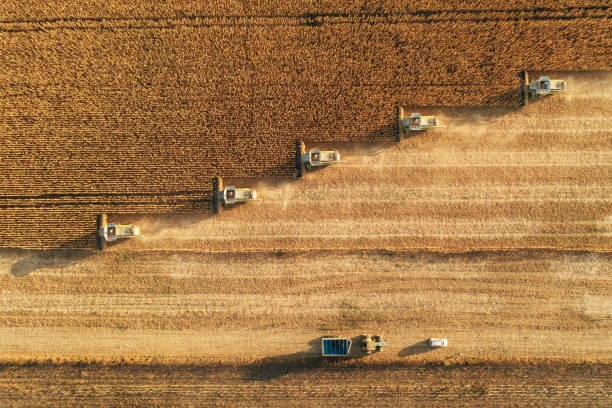The U.S. agricultural machinery market plays a vital role in modern farming. This article provides an accessible overview, key drivers, technological innovations, market challenges, and future opportunities in the U.S. market.
Agricultural machinery includes tractors, harvesters, sprayers, and irrigation systems that help farmers boost production and improve efficiency. In the U.S., growing average farm sizes, labor shortages, and the need for sustainable production have driven the adoption of modern equipment.
1. Market Overview
The U.S. agricultural machinery market is segmented into several product categories:
- Tractors: The backbone of farm mechanization.
- Harvesting Equipment: Combine harvesters, forage harvesters, and balers.
- Irrigation and Tillage Equipment: Systems that prepare and maintain fields.
- Specialized Implements: Tools for planting, spraying, and post-harvest processing.
Recent reports indicate that the market is expected to grow steadily. For example, Mordor Intelligence projects the U.S. market to reach approximately USD 42 billion by 2025 with a CAGR around 6.3%.
Another forecast suggests the market could grow from USD 38.05 billion in 2023 to USD 64.18 billion by 2032 at a CAGR of nearly 6%.
2. Key Market Drivers
Several factors drive the U.S. agricultural machinery market:
- Rising Farm Consolidation: As farm sizes increase, farmers invest in machinery to manage larger fields efficiently.
- Labor Shortages: With a shrinking agricultural labor force, automated and precise machinery becomes essential.
- Government Support: Policies and subsidy programs encourage the purchase of modern equipment.
- Technological Advancements: Innovations such as precision agriculture and autonomous machinery improve productivity and reduce costs.
3. Technological Innovations and Trends
Advancements in technology are reshaping farming:
- Precision Agriculture: Tools like GPS and sensors enable farmers to apply inputs (e.g., fertilizers and water) only where needed. This approach reduces waste and improves yields.
- Autonomous Machinery: Companies such as John Deere are leading the way. At CES 2025, John Deere unveiled fully autonomous tractors, a driverless dump truck, and an orchard-specific tractor. Their new autonomous tractors come with 16 cameras and use onboard Nvidia GPUs for real-time decision making. These innovations help address labor shortages and increase operational efficiency.
- Retrofitting Existing Equipment: John Deere now offers autonomy kits to upgrade older tractors, allowing farmers to benefit from new technology without replacing their entire fleet.
4. Major Market Players and Equipment Recommendations
Key players in the U.S. market include:
- John Deere: Known for advanced technology and a strong dealer network. Their autonomous tractor models are especially promising for large-scale operations.
- CNH Industrial: With brands like Case IH and New Holland, they offer a range of equipment from traditional tractors to smart harvesters.
- AGCO Corporation: A major supplier of diverse machinery and innovative solutions.
- Kubota: Offers compact and efficient tractors suitable for smaller or diversified farms.
Equipment Recommendation Example:
For mid-sized operations facing labor shortages, a John Deere autonomous tractor—equipped with advanced cameras and AI technology—may offer significant productivity gains. Farmers seeking retrofitting solutions to modernize their fleet can consider John Deere’s autonomy kit to update existing tractors.
5. Market Challenges
Despite promising growth, the market faces several challenges:
- Fluctuating Farm Incomes: Lower farm incomes and high interest rates can dampen new equipment purchases. For instance, Deere forecasted lower-than-expected profits for 2025 amid declining demand.
- Supply Chain Issues: Persistent supply chain disruptions can delay production and delivery.
- High Upfront Costs: Advanced machinery, especially autonomous models, come with significant premiums over traditional equipment.
6. Future Outlook and Opportunities
The long-term outlook for U.S. agricultural machinery remains positive:
- Continued Technological Adoption: As precision and autonomous technologies mature, they will drive further productivity improvements.
- Market Consolidation: Larger farms and cooperative purchasing will boost demand for high-end machinery.
- Sustainability Focus: The push for sustainable farming practices will encourage investments in equipment that reduces resource use and emissions.
Innovative technology and improved financing options are likely to help overcome short-term challenges, paving the way for steady growth in the coming years.
7. Final Insights
The U.S. agricultural machinery market is evolving rapidly. Rising farm sizes, labor shortages, and technological breakthroughs are key drivers. Companies like John Deere are setting trends with autonomous and precision equipment. Although challenges such as fluctuating incomes and high costs persist, the long-term outlook remains promising. Farmers and manufacturers who embrace these innovations are likely to lead in the competitive landscape of modern agriculture.

